- Mow once a week.
- Provide 1 inch of water per week.
- Feed your lawn.
- Kill weeds.
- Apply grass seed.
- Correct soil pH.
- Treat soil deficiencies.
- Aerate the soil.
- Dethatch the grass.
- Edge your lawn.
Do you want to achieve a picture-perfect lawn? Don’t know what to do or where to start?
Don’t call the landscaping company just yet! Did you know that mowing alone will cost you $120 on average? You can only imagine how much soil aeration, weed control, seeding, and other services cost.
So don’t worry! I’ll help you save a ton of money. I have finally figured out the recipe for growing a beautiful lawn without professional help. I would love to share my lawn maintenance tips with you, Let’s jump right into it.
10 Methods To Maintain A Healthy Lawn
Mow Regularly
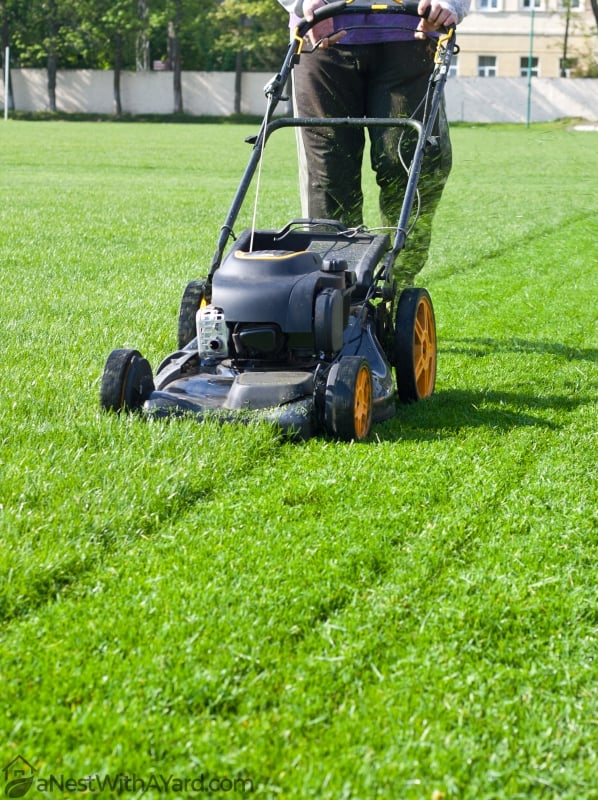
Establishing a reliable mowing routine is key to growing a thick, healthy lawn free of weeds. Regular mowing will encourage root growth and horizontal spreading to fill in those bare spots in your lawn.
In my experience, it is best to mow at least once a week during the growing season and once on a bi-weekly basis in the off-season. Click here to learn about how often you should be mowing your lawn.
How tall you should be mowing your lawn depends on the type of grass seed you are growing. Most lawn grasses prefer a mowing height of 2 to 3 inches. Two exceptions to this rule are Bermuda grass and Zoysia grass, which like to be cut at 1-inch height or less!
Before you change your lawn mower deck height, I highly suggest you look up the mowing preferences of the grass you have.
Here is a quick list of mowing tips I have learned over the years:
- Always keep your lawn mower blades sharp.
- Cut no more than one-third of the grass height at each mowing.
- Make at least two passes over your lawn. Change the angle to 45 or 90 degrees on the second pass to avoid making tire marks on the turf.
- Bag grass clippings if you are not using a mulching mower.
- Mow higher in periods of drought and extreme heat.
Water Adequately
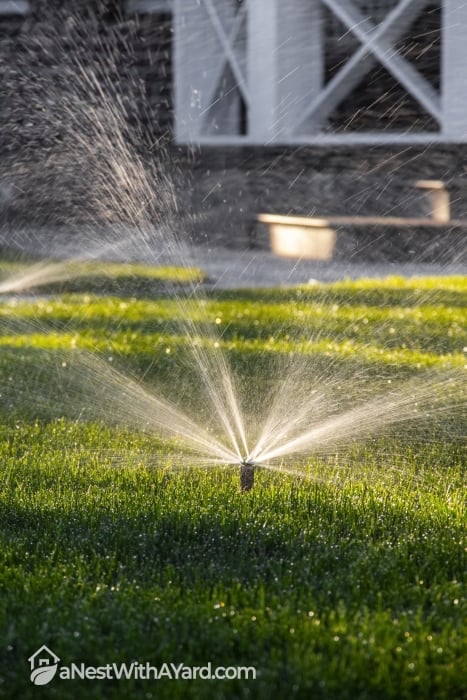
If you want a green lawn during summer, you will have to water it adequately, otherwise, it will turn brown and go dormant. I start watering my lawn from mid-May to early September. You may want to do it earlier or later depending on where you live.
Don’t water your lawn every day, unless you are growing new turf grass. In my experience, it is best to water the lawn two to three times a week. Use ¼ to ½ inch of water per every watering session. I like to let the soil dry out completely before turning on the sprinklers again to encourage better root growth.
Your lawn should get 1 to 1 ½ inches of water in total per week (rain included). Consider increasing the supply if you are trying to fix a lawn that is always dry. Adjust the amount of water you provide based on the season you are in and the amount of rain you are getting.
The best time to water your lawn is the early morning, between 6 and 10 AM. Don’t irrigate your turf during the day because the heat will evaporate water before it gets absorbed.
Watch this video for more lawn watering tips:
Feed Your Lawn

Water is not the only thing your lawn needs to prosper. It requires nutrients too. A quick way to reintroduce nutrients into the deprived soil is by using synthetic or organic fertilizers.
In my experience, the best time to fertilize your lawn is in spring and midsummer. That’s when the grass is rapidly growing and needs that extra boost of energy.
I like to apply fertilizer before it rains so that it gets melted and washed down into the soil to be absorbed. If the rain is not forecast, you will have to water your lawn after spreading the fertilizer. You don’t want to leave the agent sitting on turf for too long because it can burn grass blades.
Eradicate Weeds

Keeping weeds at bay is a challenge! Weeds compete with grass for nutrients and space, so you should do your best to prevent weeds from spreading out of control.
Luckily, there are many ways to remove weeds from grass. I suggest you first try using organic home remedies before turning to herbicides. You can kill weed spots by pouring boiling water or vinegar on them. When the weeds die, reseed the bare areas.
If your lawn has been neglected for too long, don’t shy away from using a pre-emergent and post-emergent herbicide. Their active chemicals can kill all types of broadleaf weeds and grassy weeds imaginable.
Use a pre-emergent herbicide in early spring to kill weed seeds of dallisgrass and crabgrass before they emerge from the ground. Use selective post-emergent to kill grown weeds without killing your lawn. In my experience, post-emergents work best on weed seedlings that are still young and fragile.
Apply Grass Seed
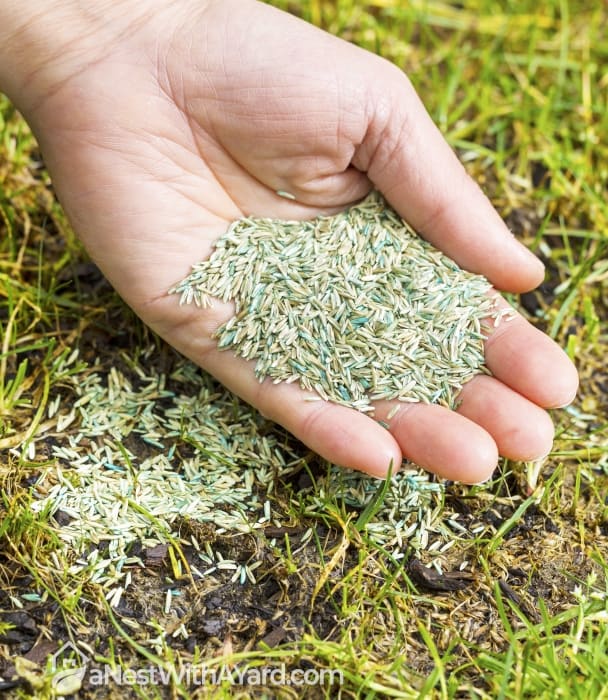
Lawns naturally thin out over time. You can quickly improve your lawn’s density by reseeding it with a robust grass seed that thrives in the climate you live in.
You can overseed your entire lawn or only focus on the problem areas. I like to spread new grass seeds on the entire surface in the spring to have a healthy lawn in summer. I reseed once more in late summer or early fall. In my opinion, you should aim to overseed your entire lawn every two years to not allow your turf to thin out.
You can overseed your warm-season grass with a cold-season variety to have a green lawn all year long! Click here to learn how to overseed Bermuda with fescue.
I also highly suggest you watch this video on how to properly overseed a lawn:
Correct Soil pH
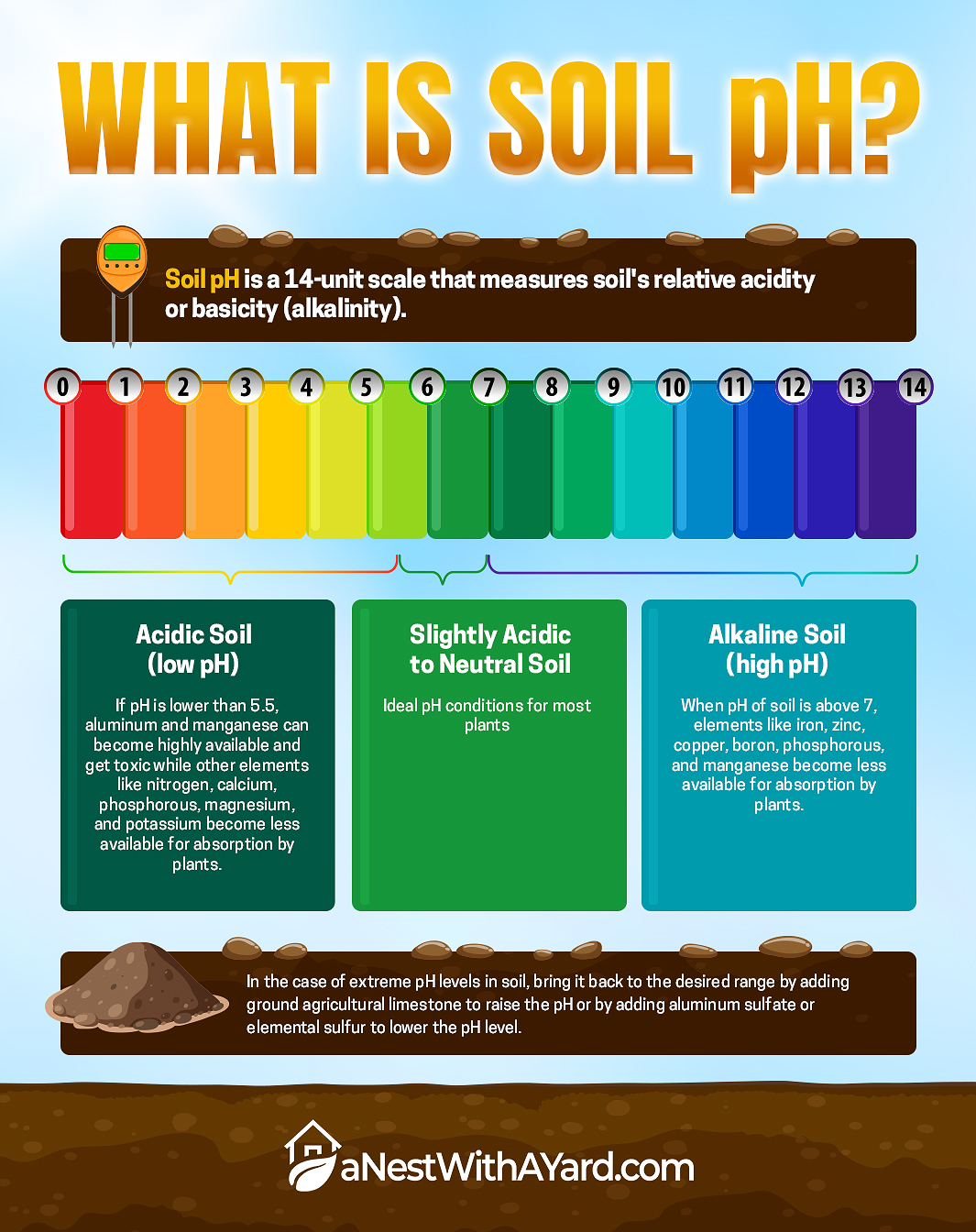
Soil is the base for every healthy lawn. If your soil pH is either too acidic or too alkaline, the grass plants won’t grow to their potential. No matter how much you water and fertilize them, they will always look dull and lifeless.
Lawns prefer soil pH between 6.0 and 7.0. The best way to ensure your soil health is up to par is by doing a pH test. You can do it at home on your own or send soil samples to the laboratory for more accurate analysis.
Once you get the soil test results, you can amend them as needed. In my experience, the best way to lower soil pH is by using elemental sulfur. It does take a year to correct the soil, but the results are long-lasting!
After many tests I have done on my soil, I figured that the best way to increase soil pH is by applying dolomite lime to the soil. I just don’t recommend using this method if your soil is already high in magnesium.
Treat Soil Deficiencies
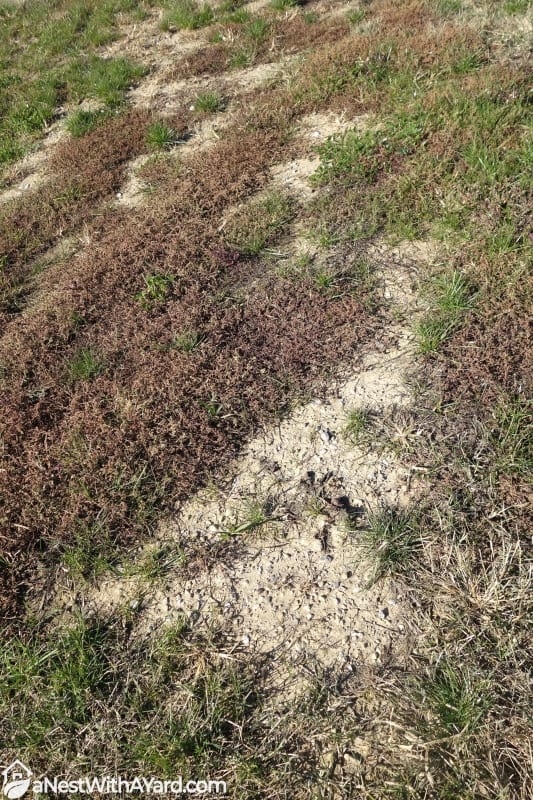
Can’t correct the yellowing and browning of grass blades despite regular watering and fertilizing? Your soil may be depleted of minerals. Soil nutrient deficiencies are a rising problem across the globe. As if that wasn’t enough, poor soil pH can make absorption of already absent minerals so much more difficult.
The best way to get to the bottom of your lawn’s stunted growth and discoloration is to do a soil nutrient test. Don’t be surprised if results for nitrogen, phosphorus, and iron come back low. These are the nutrients most commonly deficient in plants.
Treat Soil Compaction

This may come as a surprise to you, but your lawn may be in bad shape because of compacted ground. You should consider aerating your lawn if:
- Water takes time to penetrate the ground after irrigation.
- Rain pools on the surface.
- You get mud baths in the winter.
- The lawn has bare patches that won’t regrow.
If your lawn has these symptoms, use a garden fork to relieve the compaction and dry out a wet lawn. Push the garden fork 4 inches into the soil and gently rock it back and forth. Do this across the whole surface.
I like to rent out an aerator to make this tedious chore easier on my back. Based on my experience, puncturing a large lawn manually takes forever!
I recommend you aerate your lawn once a year. If you have warm-season grass, aerate the soil in early spring. If you have cool-season grass, do it in early fall.
Dethatch The Grass
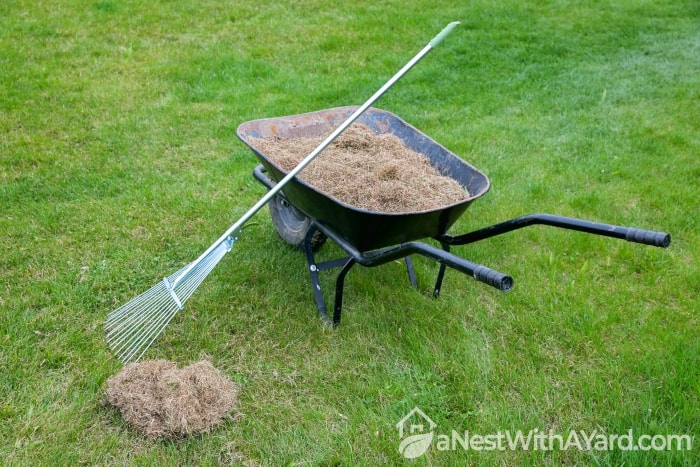
Thatch is dead grass that builds up at the base of the lawn. It can prevent air, water, and nutrients from seeping into the soil and getting to the grass roots. A thick layer of thatch can also make your turf more susceptible to weeds, insects, and lawn diseases.
The best way to protect your lawn from this type of damage is to remove thatch in time. In my opinion, you shouldn’t let the thatch get any thicker than ½ inch.
I like to remove buildup with a stiff lawn rake. You can also invest in a thatching rake or rent out a power rake. I have a whole article dedicated to the benefits of power raking and when to do it. Check it out!
Edge Your Lawn
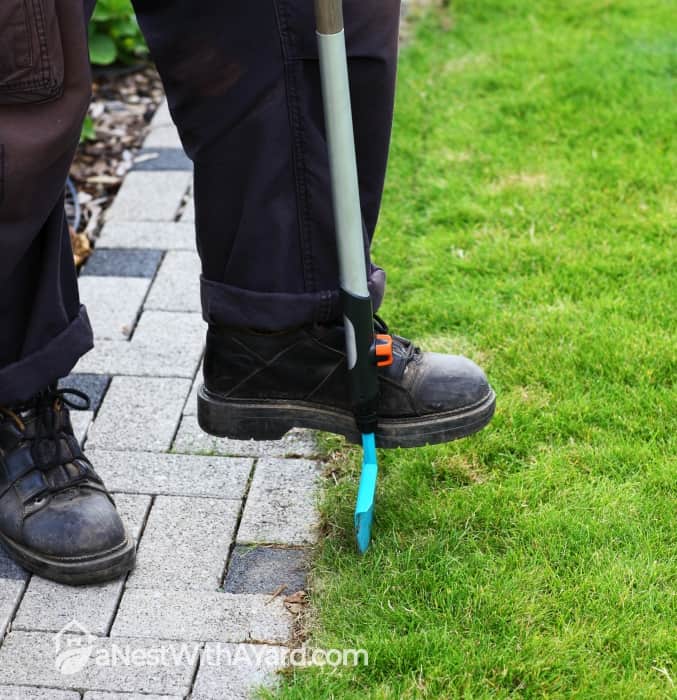
Don’t forget to edge the borders of your lawn after mowing. It is an easy way to improve curb appeal and make your lawn look professionally landscaped.
In my experience, the best way to edge a lawn is with a pair of sharp telescopic shears. If you have never edged your turf before, you may have to use a half-moon edging tool first to reshape the lawn and take off the excess grass and soil underneath.
FAQs
What are the five steps for picture perfect lawn care?
The five steps for perfect lawn care are applying crabgrass pre-emergent in early spring, laying down weed and feed in late spring, using insect protection in summer, feeding the ground with slow-release nitrogen fertilizer in fall, and feeding and aerating the lawn in winter.
What can I put on my lawn to make it healthier?
What you can put on your lawn to make it healthier is home compost or store-bought fertilizer. You can also leave mulched grass clippings on the lawn after mowing. Put organic weed control or chemical herbicide on the lawn to get rid of weeds, as well.
Can you just sprinkle grass seed on lawn?
You can just sprinkle grass seed on the lawn but good results are not guaranteed. It is better to prep the turf first by removing weeds, aerating the soil, and applying fertilizer. If you want a better yield, you will also need to water seeds every day until they sprout.
Can I fertilize my lawn every 2 months?
You can fertilize your lawn every 2 months or 5 to 6 times a year. Focus on feeding your lawn when it is growing rapidly. With that said, don’t overuse the fertilizer. Most lawns need to be fertilized only once or twice a year.
Get Your Calendar Ready
I told you! Growing a beautiful lawn isn’t all that difficult! Once you nail down your watering and feeding routine, the rest will follow. I highly suggest you create your personal lawn maintenance calendar, so you don’t forget to apply weed control, fertilizer, and grass seed in time.
Lastly, don’t feel discouraged if you don’t see the results overnight. Restoring a lawn takes time and patience! Did you enjoy reading my 10 picture-perfect lawn care steps? Let me know in the comments below, and feel free to share this article with others! They might be looking for the same solutions as you are.
If you still want to hire a lawn care service, don’t forget to read these tips about how to hire one from our irrigation expert Trevor Lively.

